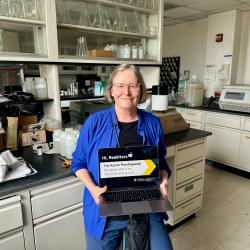UMD Geology Professor James Farquhar Elected to National Academy of Sciences
University of Maryland Geology Professor James Farquhar has been elected to the National Academy of Sciences. Farquhar also has an appointment at the Earth System Science Interdisciplinary Center (ESSIC), a joint center of the University of Maryland and NASA's Goddard Space Flight Center.
 Farquhar is one of 100 new members and 25 foreign associates elected in 2019, joining a select group of 2,347 scientists around the country—15 of whom hail from UMD—recognized for their influential research and elected by their peers. Farquhar is a scientific leader in sulfur isotope geochemistry, with publications that address geochemical processes on Earth and elsewhere in the solar system, spanning a variety of eras from the modern to the ancient.
Farquhar is one of 100 new members and 25 foreign associates elected in 2019, joining a select group of 2,347 scientists around the country—15 of whom hail from UMD—recognized for their influential research and elected by their peers. Farquhar is a scientific leader in sulfur isotope geochemistry, with publications that address geochemical processes on Earth and elsewhere in the solar system, spanning a variety of eras from the modern to the ancient.
“I am highly honored to be elected to the National Academy of Sciences,” Farquhar said. “I am very grateful to the University of Maryland; the College of Computer, Mathematical, and Natural Sciences; ESSIC; and the Department of Geology for creating an environment where I could grow and thrive.”
After graduating with a bachelor’s degree from Washington and Lee University and a master’s degree from the University of Chicago, Farquhar earned his Ph.D. in earth and atmospheric sciences from the University of Alberta, in Canada. From 1995 until 1997, he was a Carnegie Fellow at the Carnegie Institution of Washington’s Geophysical Laboratory. From 1997 until he joined UMD in 2001, Farquhar was a National Science Foundation Postdoctoral Fellow at the University of California, San Diego.
Farquhar is best known for discovering the geochemical signal that traces the long-term history of atmospheric oxygen. More recently, Farquhar and his colleagues found that Earth’s early atmosphere spent about a million years filled with a methane-rich haze.
In January 2019, Farquhar and his collaborators developed a new, more accurate system to study the history of large volcanic eruptions over the past 2,600 years. These large eruptions can launch particles into the stratosphere, more than 6 miles above Earth’s surface, where they can reflect sunlight and temporarily cool the planet.
For his next phase of work, Farquhar will team up with several collaborators at UMD to focus on methane in Earth’s modern atmosphere, using a new, state-of-the-art, high-resolution instrument called Panorama that will be established at UMD in Fall 2019.
Farquhar is a fellow of the Geochemical Society and the John Simon Guggenheim Memorial Foundation. He has received numerous awards and honors, including the Fulbright-Tocqueville Distinguished Chair Award from the Franco-American Fulbright Commission, the Samuel Epstein Medal Science Innovation Award from the European Association of Geochemistry, and the F.W. Clarke Award from the Geochemical Society.
###
Media Relations Contacts: Matthew Wright, 301-405-9267, mewright@umd.edu
University of Maryland
College of Computer, Mathematical, and Natural Sciences
2300 Symons Hall
College Park, MD 20742
www.cmns.umd.edu
@UMDscience
About the College of Computer, Mathematical, and Natural Sciences
The College of Computer, Mathematical, and Natural Sciences at the University of Maryland educates more than 9,000 future scientific leaders in its undergraduate and graduate programs each year. The college's 10 departments and more than a dozen interdisciplinary research centers foster scientific discovery with annual sponsored research funding exceeding $175 million.







